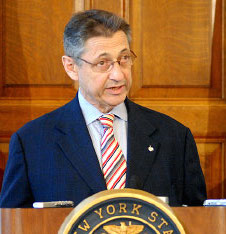
The fundamental challenge facing New York as Gov. Pa taki gave his 11th State of the State Address yesterday was essentially the same one he confronted when he first took office a decade ago.
That challenge is to rein in the runaway cost of state and local government before even more damage is done to New York’s shaky economic competitiveness.
But while the same man gave both the 1995 and 2005 State of the State speeches, the difference in focus was striking.
Ten years ago, Gov. Pataki unflinchingly faced up to the causes and implications of a $5 billion state budget gap he had inherited from Mario Cuomo.
“Surely the size of this deficit is a crisis — a crisis, as I have stated before, not of the people’s making, but of government’s,” Pataki said in his first State of the State Address.
Back then, he urged legislators to acknowledge “the simple fact” that “the government of New York state is too big, and it spends too much money.”
Fast forward to 2005. Today, the budget gap is at least $6 billion — which, even in the context of a bigger budget, is nearly as large as the “crisis” deficit of 1995. For all of Pataki’s real accomplishments earlier in his tenure, government is still too big and still spends too much. And the situation is getting worse. After all, the main reason for next year’s projected gap is an underlying spending growth rate of 12 percent — four times inflation.
But to listen to George Pataki’s 2005 State of the State Address, you’d never know the budget was a problem at all.
In a speech draft fully two-thirds longer than the 1995 version, Pataki’s message on Albany’s overriding fiscal challenge was: silence. The looming deficit for the coming fiscal year simply went unmentioned. Instead, the governor devoted the better part of an hour to reciting what is a now-familiar compendium of his administration’s greatest hits.
The governor’s litany of past success stories was mingled with the sort of bite-sized initiatives that used to be a Bill Clinton specialty — like raising awareness of toxic household chemicals, promoting healthier eating habits among children and using more “bio-fuel” in state buildings and vehicles.
Buried in the slush pile were at least three glimmers of hope.
The first and most important was Pataki’s proposal to accelerate the phase-out of the temporary income-tax hike passed over his veto in 2003. The higher income-tax rates on filers earning more than $150,000 are supposed to expire at the end of this year. Moving up this scheduled “sunset” would, as the governor suggested, send a positive message to taxpayers. It also would represent a pre-emptive strike against likely attempts by the Legislature, especially Assembly Democrats, to extend the tax hikes or make them permanent.
A related positive step was Pataki’s call for a “fairer, simpler and friendlier” tax code. If pursued, this would put tax reform and simplification back on the Albany agenda for the first time in nearly 20 years — and given President Bush’s commitment to similar changes on the federal level, it would come not a moment too soon. Pataki’s choice to lead the effort, supply-side economist Lawrence Kudlow, was a sign the governor really means business.
The third hopeful sign was Pataki’s promise to push for “Medicaid reforms that will reduce costs and also protect county property taxpayers, while ensuring the quality of health care we all deserve.”
These items aside, the 2005 speech contained few echoes of the Reaganesque themes from 10 years earlier. The contrast was striking not only with the Gov. Pataki of 1995, but with the current governor of another, similarly troubled big state.
Hours after Pataki’s speech, Arnold Schwarzenegger delivered his second State of the State Address to the California legislature. With less than two years in office, Schwarzenegger is still willing to push the kind of reforms that would truly deserve Pataki’s favorite adjective: “bold.”
For example, Schwarzenegger has proposed scrapping California’s lavish guaranteed public pensions and replacing them with a 401(k)-style plan. This sets the stage for the sort of momentous confrontation with powerful public-employee unions that Pataki has studiously avoided for most of the past decade.
Gubernatorial hyperbole aside, New York took some giant steps forward in the mid-to-late 1990s. However, it also has taken some giant steps backward in more recent years. Government here is nearly as big a problem as ever. And the time George Pataki has left to do something about it is quickly running out.






